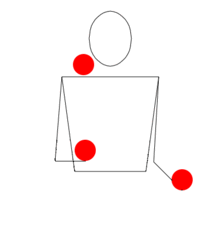Cascade (juggling)

In juggling, a cascade is the simplest juggling pattern achievable with an odd number of props. The simplest juggling pattern is the three-ball cascade.[1] This is therefore the first pattern that most jugglers learn.
In the cascade, an object is always thrown from a position near the body's midline in an arc passing underneath the preceding throw and toward the other side of the body, where it is caught and transported again toward the body's midline for the next throw. As a result, the balls travel along the figure-eight path that is characteristic of the cascade.—[1]
Three-ball cascade
For the three-ball cascade the juggler starts with two balls in one hand and the third ball in the other hand. One ball is thrown from the first hand in an arc to the other hand. Before catching this ball the juggler must throw the ball in the receiving hand, in a similar arc, to the first hand. The pattern continues in this manner with each hand in turn throwing one ball and catching another.
All balls are caught on the outside of the pattern (on the far left and right) and thrown from closer to the middle of the pattern. The hand moves toward the middle to throw, and back towards the outside to catch the next object. Because the hands must move up and down when throwing and catching, putting this movement together causes the left hand to move in a counterclockwise motion, and the right hand to move in a clockwise motion.
This pattern is achievable with a wide array of props besides regular balls. Commonly used props are clubs, rings and scarves. Because of their slow falling speed due to high air resistance, scarves are often used as a first prop for beginning jugglers.
The cascade is only performed with an odd number of objects (3, 5, 7, etc.) The basic pattern for an even number of objects is the fountain.
Greater numbers of props

When extended to higher numbers of props (five, seven, nine, etc.) the cascade maintains the basic pattern of throwing one prop before catching another on its way down. Higher numbers require the balls to be tossed higher into the air in order to allow more time for a complete cycle of throws. However, in order to keep the number of props in the juggler's hands to a minimum, it is necessary to begin the pattern by throwing, from alternating hands, all but one prop (in the same hand as the first throw, which started with one more prop than the other) before any catches are made.
Reverse cascade

The reverse cascade is a juggling pattern in which the props follow the same path as the cascade, but with time going backwards, hence the 'reverse'.
The pattern is performed with an odd number of props. As in the cascade, props are thrown from alternating hands and each prop is caught in the opposite hand from which it was thrown. The key difference between a regular cascade and the reverse cascade (from a juggler's point of view) is that one throws each object over rather than under the others.
While in a cascade objects are caught on the outside of the pattern (on the far left and right) and thrown from closer to the middle of the pattern, causing each ball to pass under the ball previously thrown, in a reverse cascade objects are caught near the middle of the pattern and thrown from the outside, causing each ball to pass above the ball previously thrown. Thus from the juggler's perspective the left hand moves in a clockwise motion, and the right hand in a counterclockwise motion.
The reverse cascade is generally considered to be more difficult to perform than the cascade.[citation needed]
Sources
- ↑ 1.0 1.1 Bernstein, Nicholai A. (1996). Dexterity and Its Development, p.379. ISBN 9781410603357.
External links
| |||||||||||||||||||
